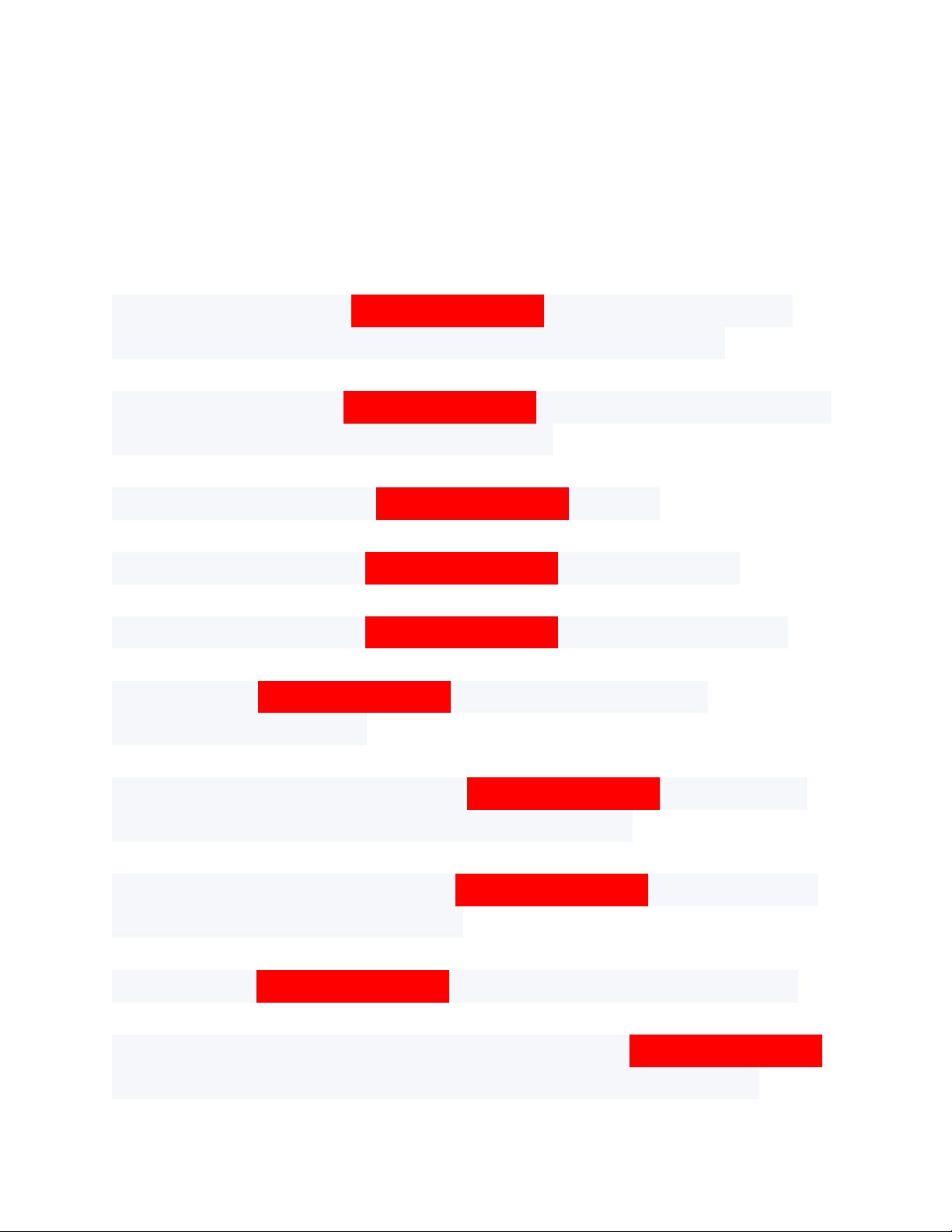
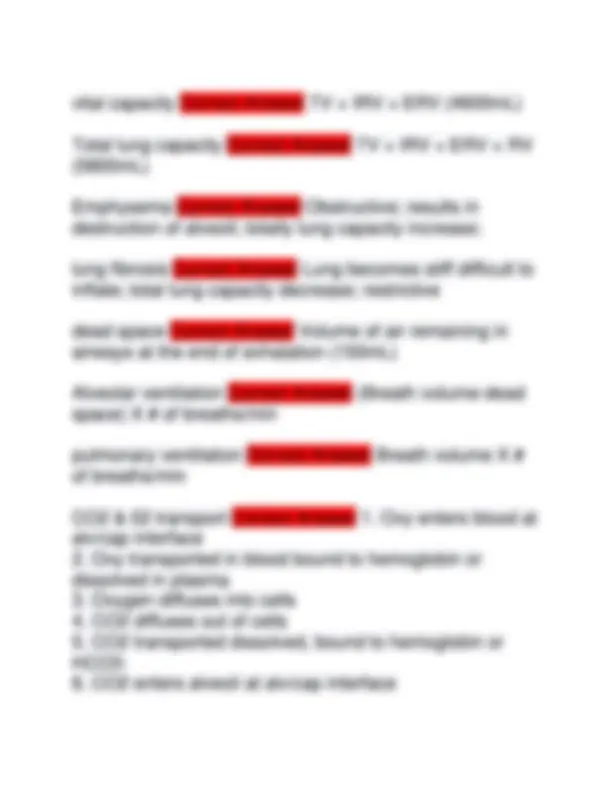
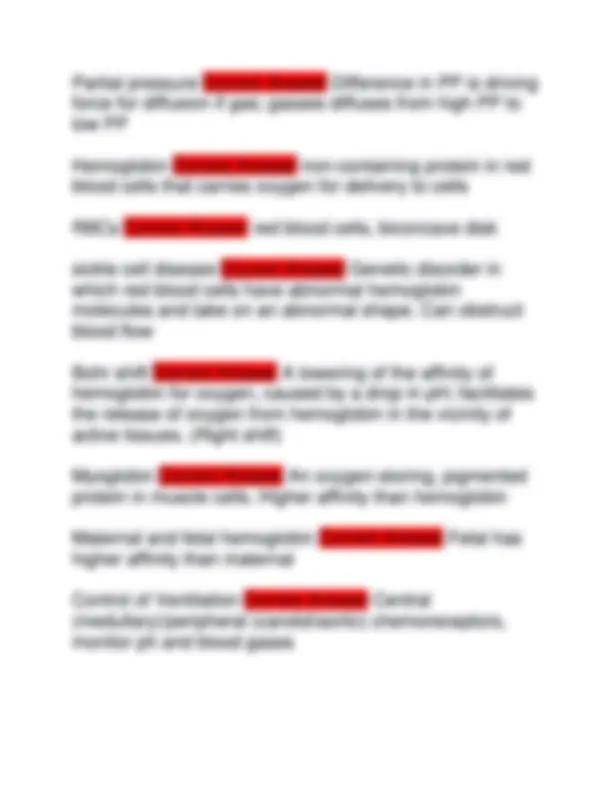
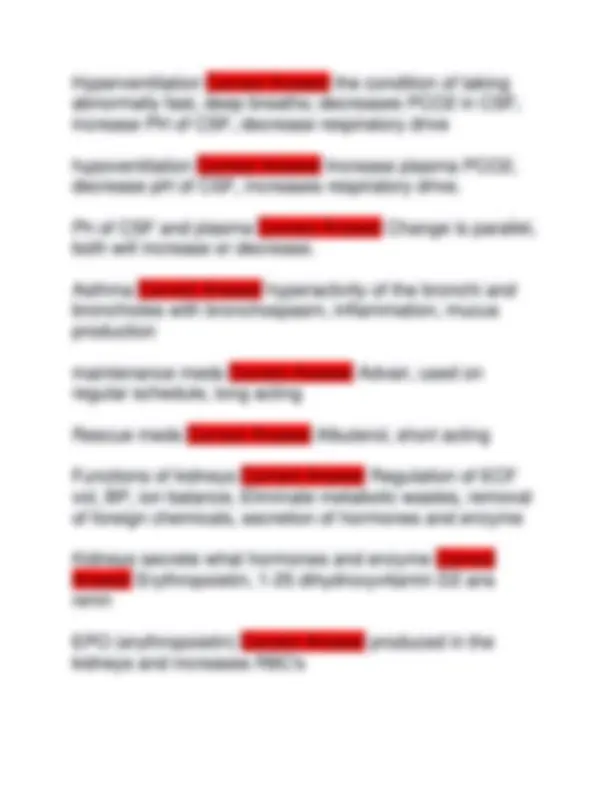
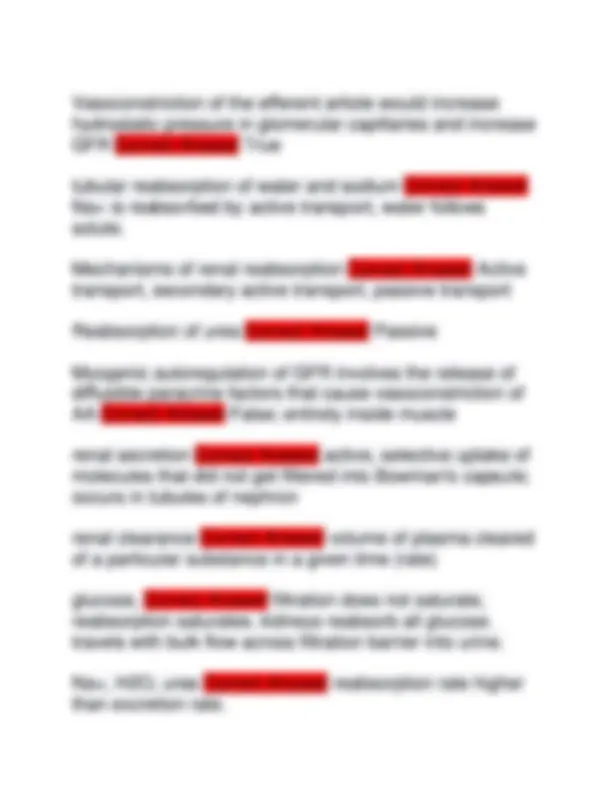
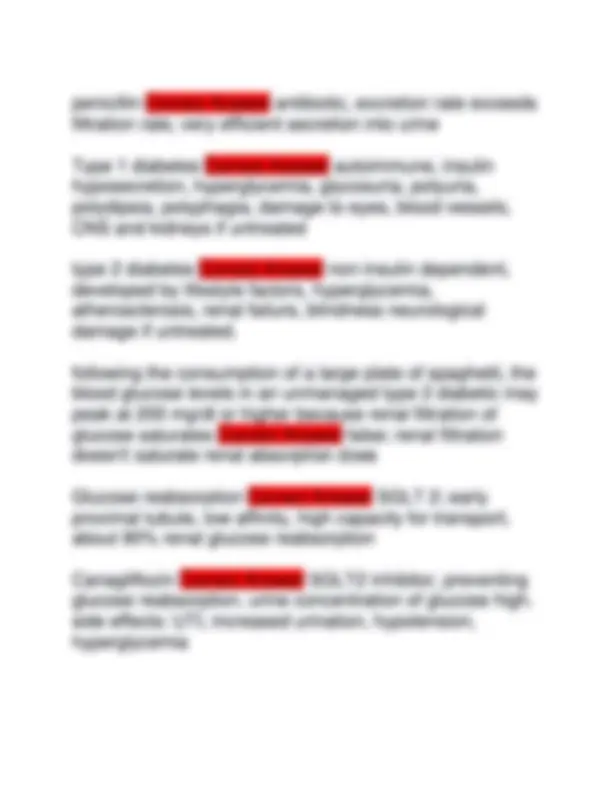
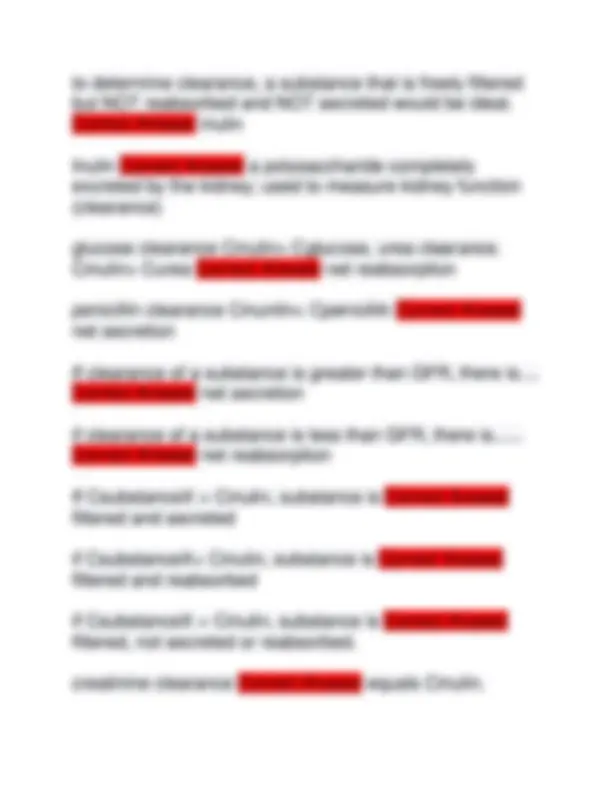
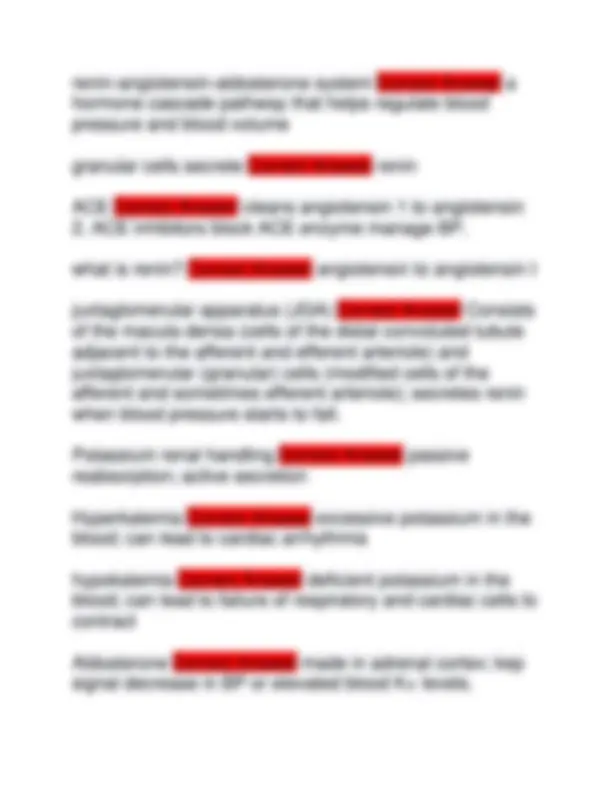
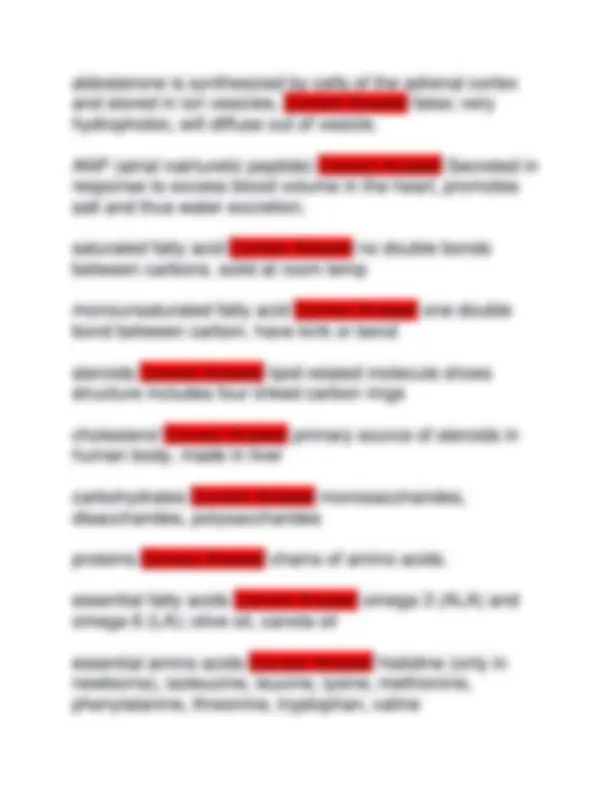
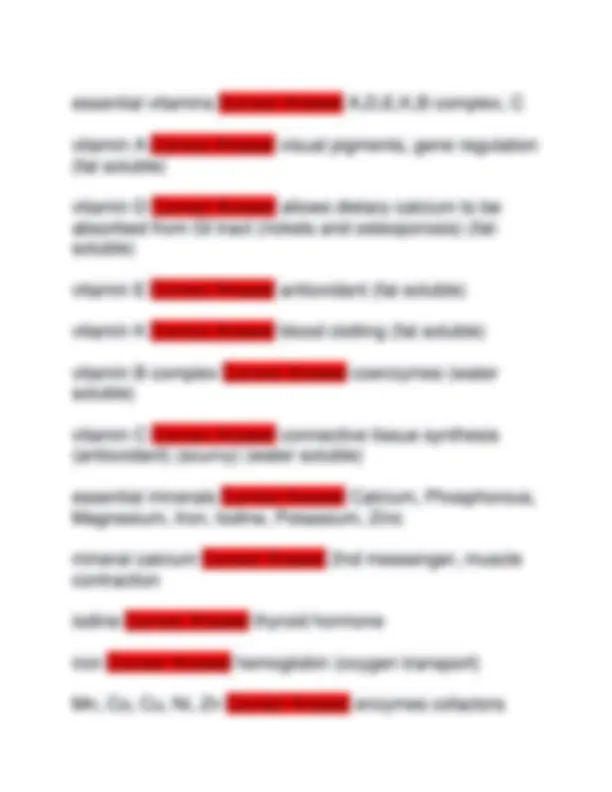
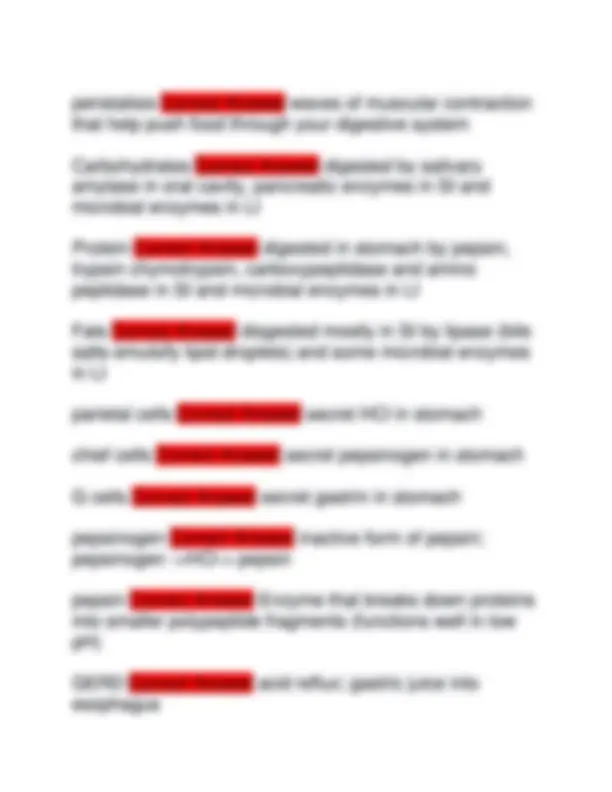
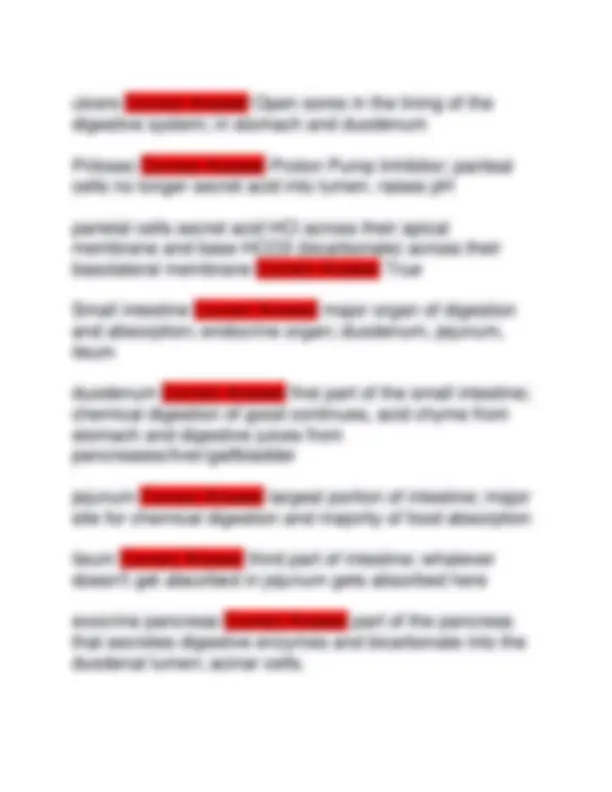
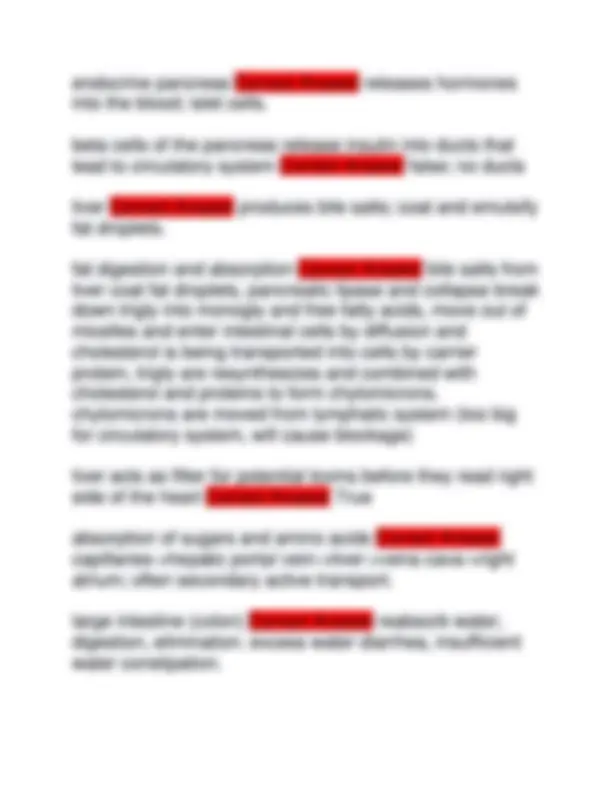
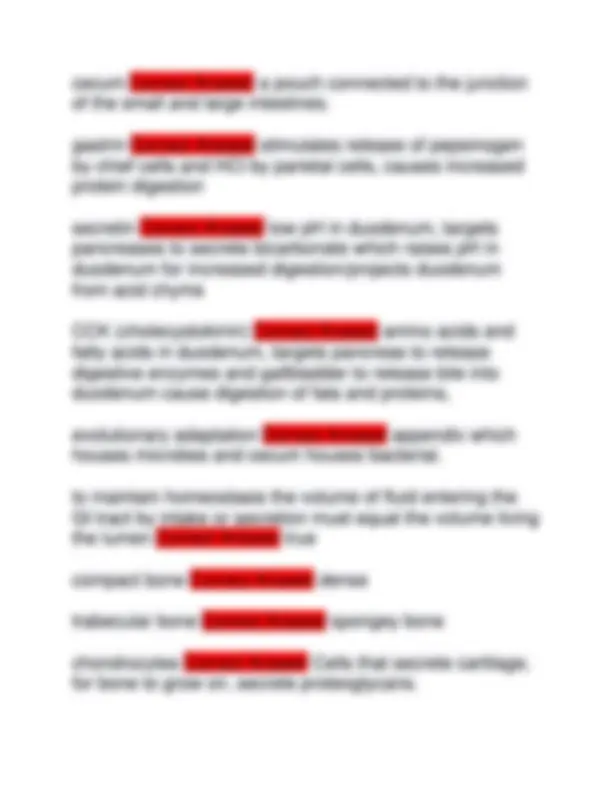
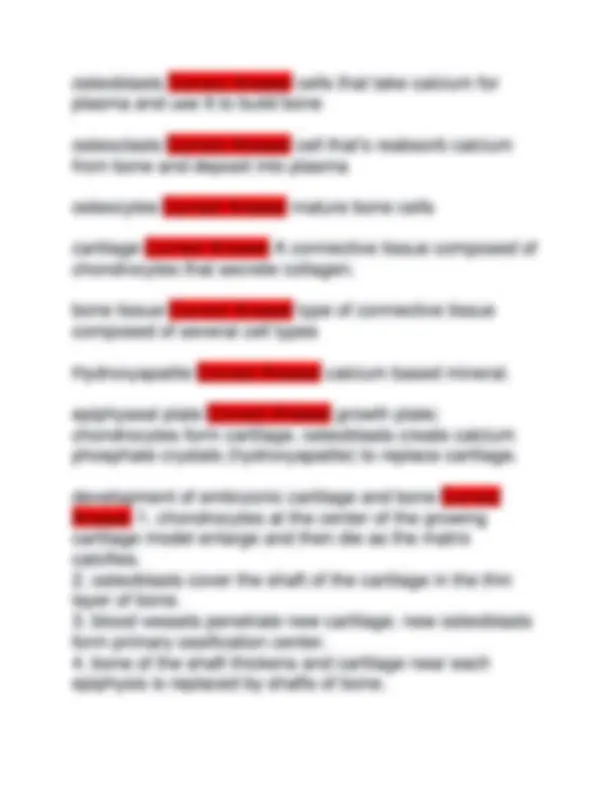
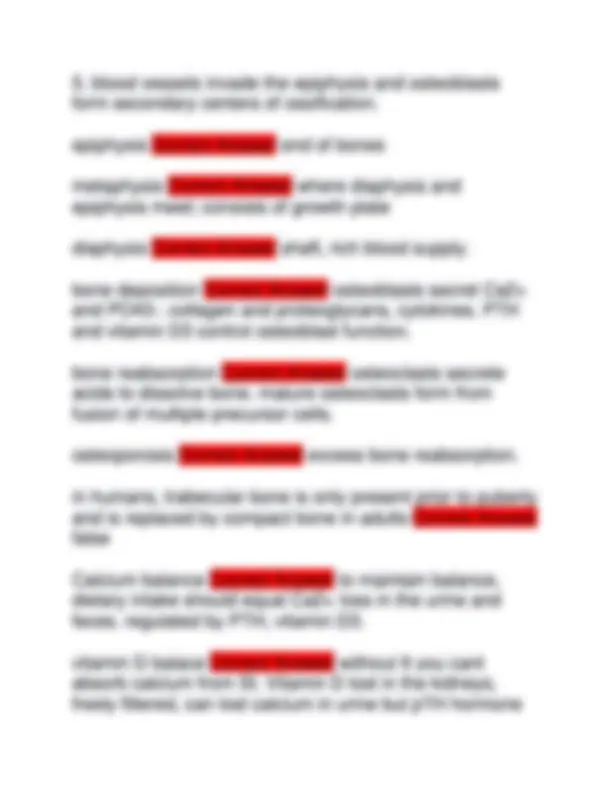
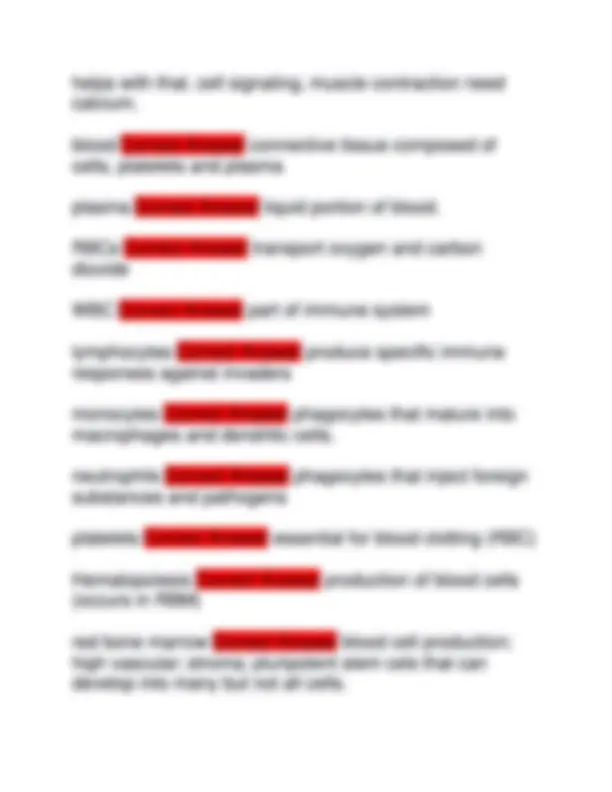
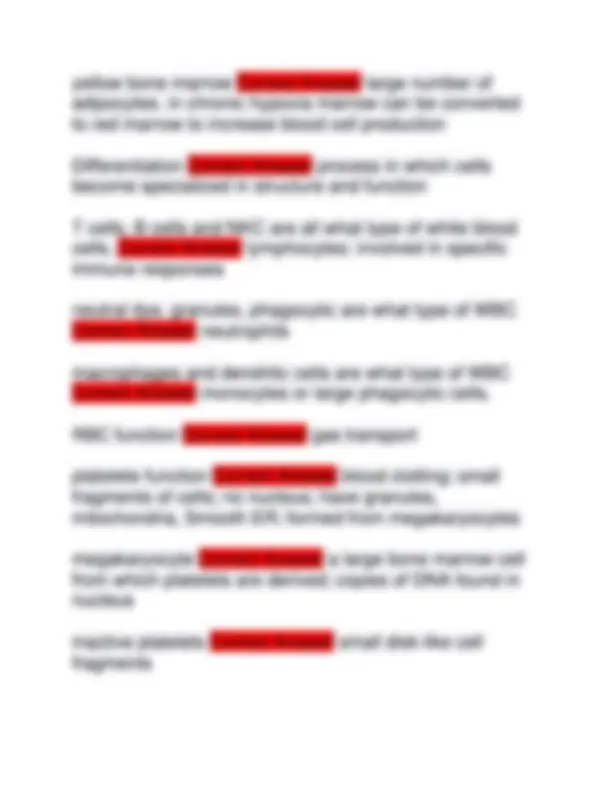
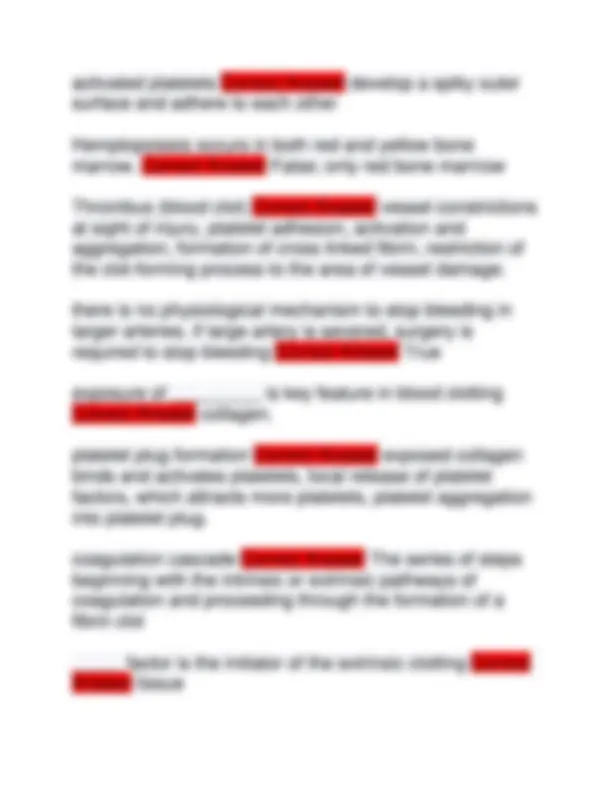
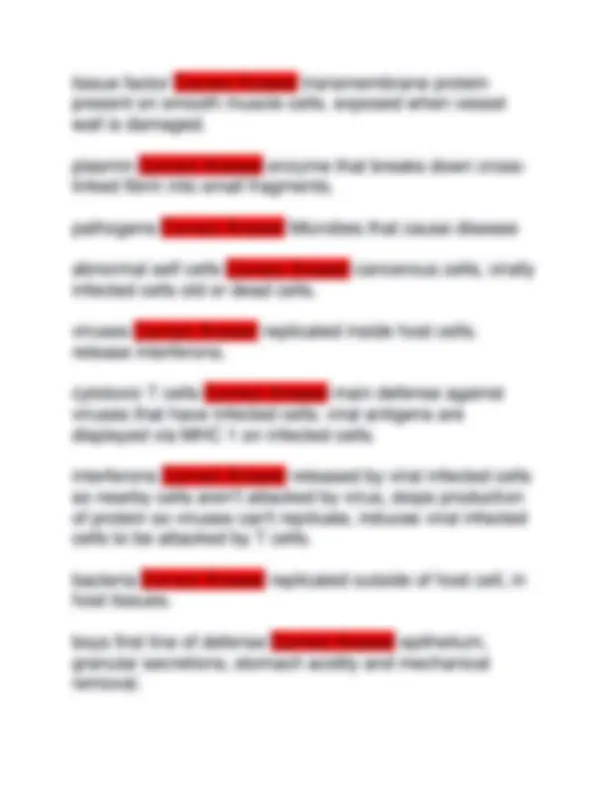
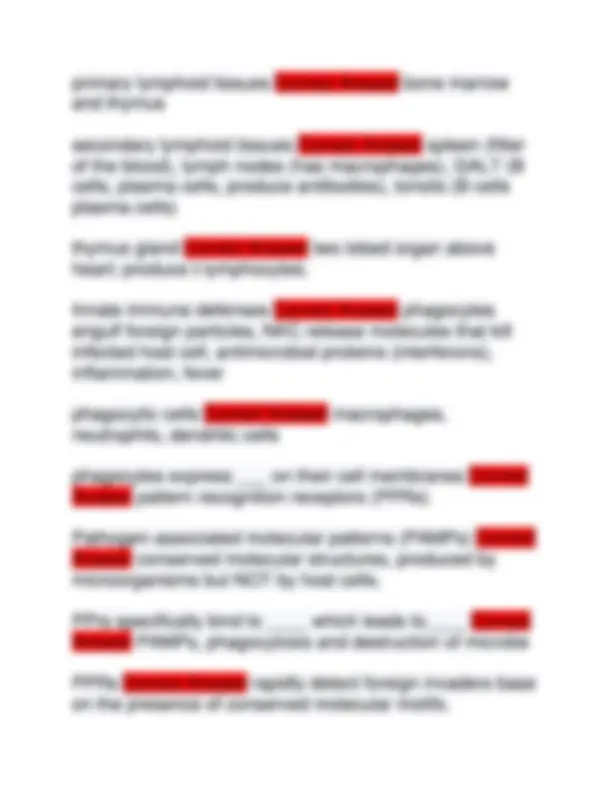
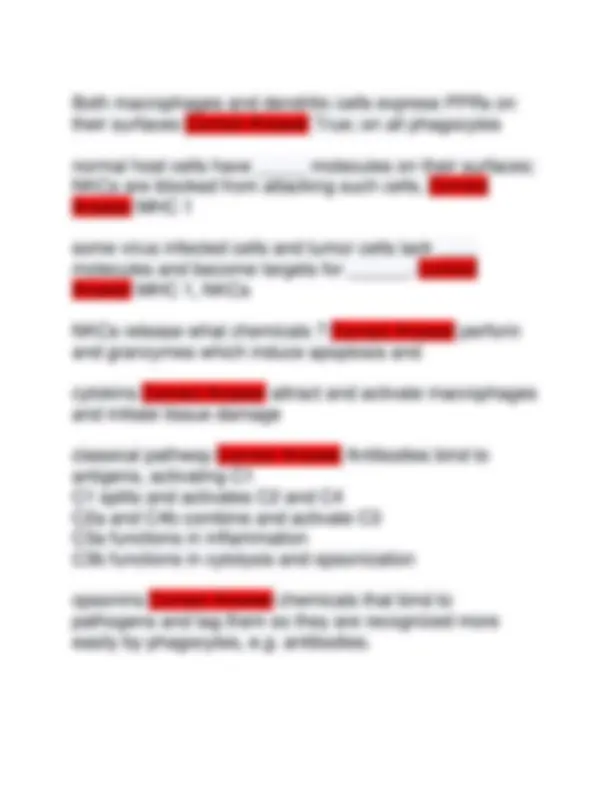
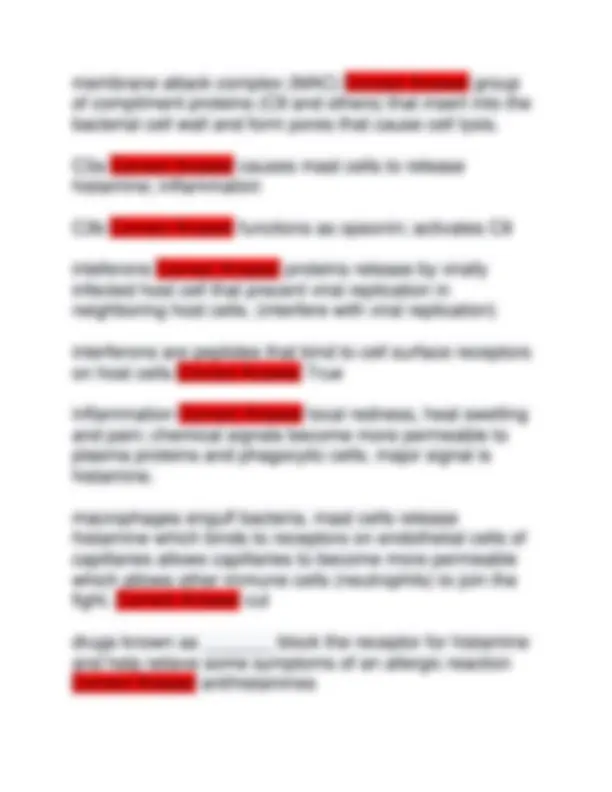
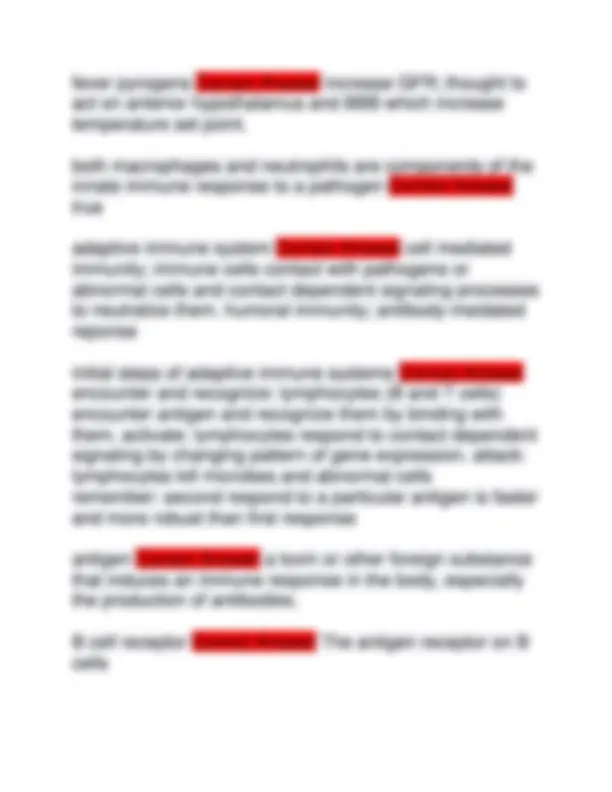
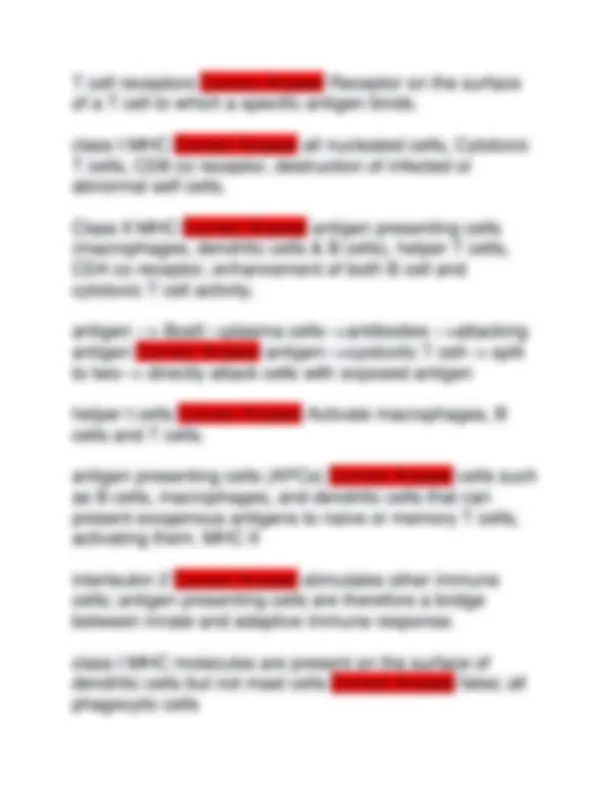
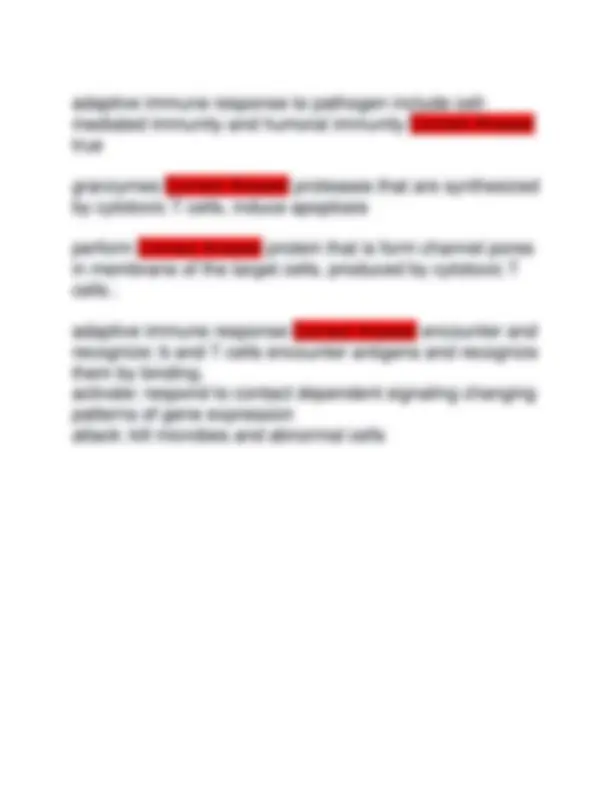


Study with the several resources on Docsity

Earn points by helping other students or get them with a premium plan


Prepare for your exams
Study with the several resources on Docsity

Earn points to download
Earn points by helping other students or get them with a premium plan
Community
Ask the community for help and clear up your study doubts
Discover the best universities in your country according to Docsity users
Free resources
Download our free guides on studying techniques, anxiety management strategies, and thesis advice from Docsity tutors
BIO 203 SBU EXAM 2025 NEWEST QUESTIONS AND CORRECT ANSWERS | A+ GRADE STUDY RESOURCE
Typology: Exams
1 / 33

This page cannot be seen from the preview
Don't miss anything!


























conducting system Correct Answer Trachea, bronchus, bronchiole, terminal bronchiole. No gas exchangs Exchange surface Correct Answer Respiratory bronchiole, alveolar duct, alveolar sac, alveolus site of gas exchange Correct Answer Alveoli type 1 alveolar cells Correct Answer gas exchange type 2 alveolar cells Correct Answer secrete surfactant Pleural sac Correct Answer a double membrane surrounding the lung negative pressure breathing Correct Answer a breathing system in which air is pulled into the lungs positive pressure breathing Correct Answer Mechanically forced air (CPR, Trach tube) Diaphragm Correct Answer major muscle of inspiration. Quiet breathing inspiration and expiration Correct Answer Inspiration: active process, contraction of diaphragm
(flattens), thoracic vol increases; expiration: passive process, relaxation, thoracic vol decreases. alveolar pressure Correct Answer Inspiration: 0,-1,0; expiration 0, 1, 0 intrapleural pressure Correct Answer Inspiration - 3, - 6; expiration - 6, - 3 pnuemothorax Correct Answer collapsed lung, air in thorax Surfactant Correct Answer More concentrated in smaller alveoli which equalizes pressure in small and large alveoli premature babies Correct Answer Inadequate surfactant concentrations; Newborn respiratory distress syndrome tidal volume Correct Answer Amount of air that moves in and out of the lungs during a normal breath (500mL) expiratory reserve volume Correct Answer Additional volume of air that can be expired from the lungs by a forceful effort following a normal expiration (1100mL) inspiratory reserve volume Correct Answer Maximal volume of additional air that can be drawn into the lungs by a forceful effort following a normal inspiration (3000mL) residual volume Correct Answer Volume of air remaining in lungs at the end of the forced exhalation (1200mL)
Partial pressure Correct Answer Difference in PP is driving force for diffusion if gas; gasses diffuses from high PP to low PP Hemoglobin Correct Answer iron-containing protein in red blood cells that carries oxygen for delivery to cells RBCs Correct Answer red blood cells, biconcave disk sickle cell disease Correct Answer Genetic disorder in which red blood cells have abnormal hemoglobin molecules and take on an abnormal shape. Can obstruct blood flow Bohr shift Correct Answer A lowering of the affinity of hemoglobin for oxygen, caused by a drop in pH; facilitates the release of oxygen from hemoglobin in the vicinity of active tissues. (Right shift) Myoglobin Correct Answer An oxygen-storing, pigmented protein in muscle cells. Higher affinity than hemoglobin Maternal and fetal hemoglobin Correct Answer Fetal has higher affinity than maternal Control of Ventilation Correct Answer Central (medullary)/peripheral (carotid/aortic) chemoreceptors, monitor ph and blood gases
Hyperventilation Correct Answer the condition of taking abnormally fast, deep breaths; decreases PCO2 in CSF, increase PH of CSF, decrease respiratory drive hypoventilation Correct Answer Increase plasma PCO2, decrease pH of CSF, increases respiratory drive. Ph of CSF and plasma Correct Answer Change is parallel, both will increase or decrease. Asthma Correct Answer hyperactivity of the bronchi and bronchioles with bronchospasm, inflammation, mucus production maintenance meds Correct Answer Advair, used on regular schedule, long acting Rescue meds Correct Answer Albuterol, short acting Functions of kidneys Correct Answer Regulation of ECF vol, BP, ion balance, Eliminate metabolic wastes, removal of foreign chemicals, secretion of hormones and enzyme Kidneys secrete what hormones and enzyme Correct Answer Erythropoietin, 1-25 dihydroxyvitamin D2 ans renin EPO (erythropoietin) Correct Answer produced in the kidneys and increases RBC's
functions of nephron Correct Answer filtration, reabsorption, secretion, excretion blood flow in nephron Correct Answer afferent arteriole, glomerulus, efferent arteriole, peritubular capillaries, to renal vein glomerular filtration Correct Answer Endothelial cells, basement membrane, foot process of podocyte, size selective only glucose, sodium and small peptides. GFR (glomerular filtration rate) Correct Answer 180L/day myogenic response Correct Answer Increase BP in AA cause vessel wall to stretch, ion channels open and cells depolarize, deplolarization opens Ca2+ channels leading to vasoconstriction, limits blood flow to glomerulus and filtration pressure decreases tubuloglomerular feedback Correct Answer 1. GFR increase, 2. Flow through proximal tubule, 3. Flow past macula densa increase, 4. Paracrine factors from macula densa (adenosine), 5. AA contrict, resistance in AA increases, HP in glomerulus decreases GFR decreases. Extrinsic regulation of GFR: neural Correct Answer Release of NE, afferent muscle cells constrict in response to NE, GFR decreases Extrinsic Regulation of GFR: hormonal Correct Answer Angiotensin II Vaso constricts AA which lowers GFR
Vasoconstriction of the efferent artiole would increase hydrostatic pressure in glomerular capillaries and increase GFR Correct Answer True tubular reabsorption of water and sodium Correct Answer Na+ is reabsorbed by active transport, water follows solute. Mechanisms of renal reabsorption Correct Answer Active transport, secondary active transport, passive transport Reabsorption of urea Correct Answer Passive Myogenic autoregulation of GFR involves the release of diffusible paracrine factors that cause vasoconstriction of AA Correct Answer False; entirely inside muscle renal secretion Correct Answer active, selective uptake of molecules that did not get filtered into Bowman's capsule; occurs in tubules of nephron renal clearance Correct Answer volume of plasma cleared of a particular substance in a given time (rate) glucose, Correct Answer filtration does not saturate, reabsorption saturates. kidneys reabsorb all glucose. travels with bulk flow across filtration barrier into urine. Na+, H2O, urea Correct Answer reabsorption rate higher than excretion rate.
to determine clearance, a substance that is freely filtered but NOT reabsorbed and NOT secreted would be ideal. Correct Answer inulin Inulin Correct Answer a polysaccharide completely excreted by the kidney; used to measure kidney function (clearance) glucose clearance Cinulin> Cglucose, urea clearance. Cinulin> Curea Correct Answer net reabsorption penicillin clearance Cinunlin< Cpenicillin Correct Answer net secretion If clearance of a substance is greater than GFR, there is.... Correct Answer net secretion if clearance of a substance is less than GFR, there is...... Correct Answer net reabsorption If CsubstanceX > Cinulin, substance is Correct Answer filtered and secreted if CsubstanceX< Cinulin, substance is Correct Answer filtered and reabsorbed if CsubstanceX = Cinulin, substance is Correct Answer filtered, not secreted or reabsorbed. creatinine clearance Correct Answer equals Cinulin.
the units for clearance for mL/min and the mL refers to volume of urine collected Correct Answer false regulatory systems Correct Answer AVP/ADH, RAAS, natriuretic peptides Desending limb Correct Answer only water reabsorbed; ascending limb Correct Answer only ions reabsorbed proximal tubule Correct Answer reabsorption (water and ions) and secretion distal tubule Correct Answer reabsorption and secretion loops of henle Correct Answer reabsorption collecting duct Correct Answer reabsorption, secretion and excretion (end of collecting duct) pertubular capillaries Correct Answer reabsorption AVP/ADH Correct Answer controls trafficking of aquaporin-2 water channels in collecting duct. AVP made and packaged in hypothalamus, vesicular transport down axon to posterior pituitary where stored until released into blood, to collecting duct where insertion of water pores in apical membrane, increases water reabsorption. alcohol inhibits release of AVP.
renin-angiotensin-aldosterone system Correct Answer a hormone cascade pathway that helps regulate blood pressure and blood volume granular cells secrete Correct Answer renin ACE Correct Answer cleans angiotensin 1 to angiotensin
aldosterone is synthesized by cells of the adrenal cortex and stored in ion vesicles. Correct Answer false; very hydrophobic, will diffuse out of vesicle. ANP (atrial natriuretic peptide) Correct Answer Secreted in response to excess blood volume in the heart, promotes salt and thus water excretion. saturated fatty acid Correct Answer no double bonds between carbons. solid at room temp monounsaturated fatty acid Correct Answer one double bond between carbon. have kink or bend steroids Correct Answer lipid-related molecule shoes structure includes four linked carbon rings cholesterol Correct Answer primary source of steroids in human body. made in liver carbohydrates Correct Answer monosaccharides, disaccharides, polysaccharides proteins Correct Answer chains of amino acids. essential fatty acids Correct Answer omega 3 (ALA) and omega 6 (LA); olive oil, canola oil essential amino acids Correct Answer histidine (only in newborns), isoleucine, leucine, lysine, methionine, phenylalanine, threonine, tryptophan, valine
Alimentary canal Correct Answer digestive tube that extends from the mouth to the anus. two openings for ingestion and elimination parts of the alimentary canal Correct Answer mouth, pharynx, esophagus, stomach, small intestine, large intestine accessory organs of the digestion Correct Answer salivary glands, pancreas, liver, gallbladder food flow Correct Answer oral cavity-> esophagus-
stomach-> small intestine->large intestine->anus salivary glands Correct Answer exocrine glands, parotid, sublingual, submandibular parotid gland Correct Answer rich in enzymes, amylase siblingual gland Correct Answer rich in mucins (provides lubrication) submandibular gland Correct Answer both enzymes and mucins production of saliva Correct Answer 1. acinar cells secrete fluids similar to ECF, enzymes mucins secreted. involves several transporters, channels and pumps. AQP present.
taste buds Correct Answer the organ of taste transduction. 3 types of cells type 1 taste cells Correct Answer support cells; salt type 2 taste cells Correct Answer receptor cells; sweet Unami, bitter; release ATP type 3 taste cells Correct Answer presynaptic cells; sour; release serotonin taste transduction Correct Answer ligands (taste buds) activate taste cell activating numerous intracellular pathways, Ca2+ signal triggers exocytosis or ATP formation. serotonin or ATP released causing primary sensory neuron to fire and AP sent to brain, salivary glands are endocrine glands that secret hypotonic aqueous solution (saliva) Correct Answer false; exocrine glands Deglutition (swallowing) Correct Answer tongue pushes bolus against soft palate and back of mouth, triggering swallowing reflex, breathing inhibited by epiglottis, food moves downward into esophagus propelled by peristaltic waves and gravity. in human taste buds, sweet, Unami and bitter substances act as ligands and activate G protein coupled receptors. Correct Answer True
ulcers Correct Answer Open sores in the lining of the digestive system; in stomach and duodenum Prilosec Correct Answer Proton Pump Inhibitor; pariteal cells no longer secret acid into lumen. raises pH parietal cells secret acid HCl across their apical membrane and base HCO3 (bicarbonate) across their basolateral membrane Correct Answer True Small intestine Correct Answer major organ of digestion and absorption; endocrine organ; duodenum, jejunum, ileum duodenum Correct Answer first part of the small intestine; chemical digestion of good continues, acid chyme from stomach and digestive juices from pancreases/liver/gallbladder jejunum Correct Answer largest portion of intestine; major site for chemical digestion and majority of food absorption ileum Correct Answer third part of intestine; whatever doesn't get absorbed in jejunum gets absorbed here exocrine pancreas Correct Answer part of the pancreas that secretes digestive enzymes and bicarbonate into the duodenal lumen; acinar cells.
endocrine pancreas Correct Answer releases hormones into the blood; islet cells. beta cells of the pancreas release insulin into ducts that lead to circulatory system Correct Answer false; no ducts liver Correct Answer produces bile salts; coat and emulsify fat droplets. fat digestion and absorption Correct Answer bile salts from liver coat fat droplets, pancreatic lipase and collapse break down trigly into monogly and free fatty acids, move out of micelles and enter intestinal cells by diffusion and cholesterol is being transported into cells by carrier protein, trigly are resynthesizes and combined with cholesterol and proteins to form chylomicrons. chylomicrons are moved from lymphatic system (too big for circulatory system, will cause blockage) liver acts as filter for potential toxins before they read right side of the heart Correct Answer True absorption of sugars and amino acids Correct Answer capillaries->hepatic portal vein->liver->vena cava->right atrium; often secondary active transport. large intestine (colon) Correct Answer reabsorb water, digestion, elimination. excess water diarrhea, insufficient water constipation.